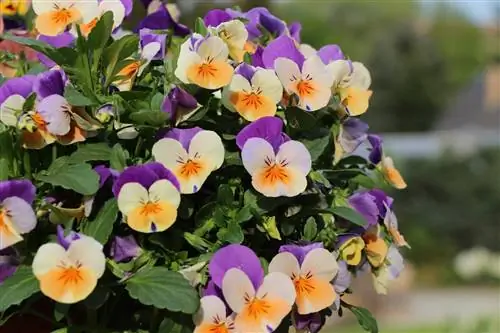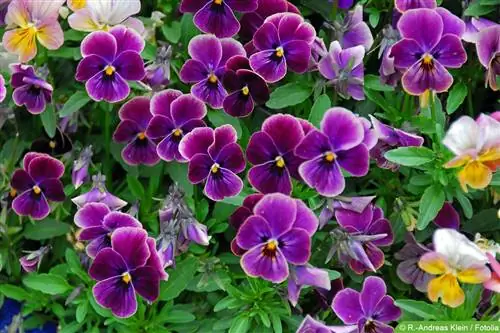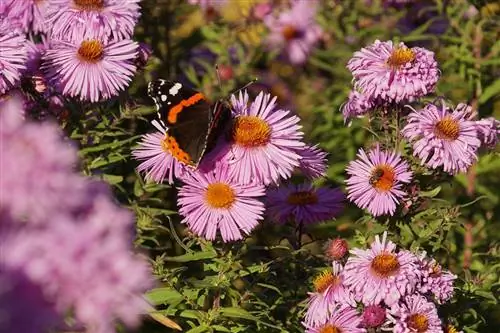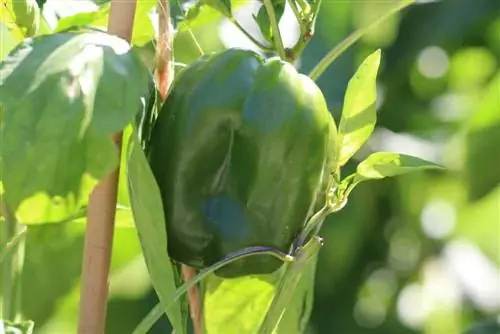- Author admin [email protected].
- Public 2023-12-17 03:39.
- Last modified 2025-06-01 06:48.
Bare earth on the edges of trees is a thing of the past: horned violets with their bushy, sprawling growth love the partial shade on the edges of trees. They are also excellent ground cover plants. Horned violets bloom profusely and colorfully on the edge of the tree, in the bed or in the planter. They give every location an enchanted flair. These small, delicate plants have a lot to offer. They enchant the senses. The delicate flowers bounce above the evergreen leaves of the 'Viola cornuta' at any time of the year. The sight of them brings happiness and their scent enchants. They do not place great demands on gardening skills, are easy to care for, undemanding and long-lasting.
Location and soil
The horned violets require loose, permeable and humus-rich soil in sun to partial shade. 'Viola cornuta' is not suitable for a full sun, hot and dry location. Horned violets reach a height of 15 to 20 cm. In order to skillfully showcase their beauty, choosing the right location is important. 'Viola cornuta' finds the right place in rock gardens, beds, borders, bed borders and tree edges. Their effect as a carpet of flowers in the vicinity of anemones, bluebells, grasses, carnations, primroses and low ferns is enchantingly beautiful.
Humoser, loamy, permeable and moist soil offers the horned violets optimal growing conditions. But they can cope with all water-permeable, loose soils, even the poor soils of a rock garden. The only important things are water permeability and loose soil. The small violets cannot tolerate waterlogging. They also don't do well on heavily rooted soil. If the location offers them loose and water-permeable soil, these delicate beauties will reward the gardener with powerful growth and lots of flowers.
Location on terrace and balcony
Horn violets also develop their beauty and scent in planters, hanging baskets and bowls. Normal potting soil is required. All containers require a drain to avoid waterlogging.
Care
The horned violets thrive in even moisture. In dry periods they need irrigation water. There should be no waterlogging. During the growth phases, the horned violet is grateful for a moderate amount of nutrients. Small doses of nutrients are sufficient and only when the flowering power decreases or when the second flower is just forming. If you use too much fertilizer, the shoots of this delicate perennial become longer and longer. They become so thin that they will collapse during the next rain shower.
Tip:
If there is a sudden increase in height, stop any fertilizer application immediately.
In order to increase longevity and flowering, pruning after the first flowering is recommended. Shortened by half, the plant sprouts powerfully and bushy. The plant thanks the pruning with longevity and many flowers. If the second flower is not cut back, seeds will ripen. The horned violet sows itself. This delicate perennial conquers the garden via root runners and seeds. Unfortunately for a gardener, snails particularly love horned violet varieties grown from cuttings. A snail protection is recommended.
Propagation
The horned violets are 'perennials'. They are propagated by seeds or cuttings. Each type of propagation has its own special properties. Horned violets, which can be propagated by seeds, can be grown more quickly. Because they can be sown directly on site throughout the summer. The collected seeds are sown immediately. It needs the cold of winter to germinate and only delights the senses in spring with leaves and flowers. The genes of the 'Viola cornuta' constantly mix. The result is surprisingly varied flower colors. Commercially purchased seeds were treated with artificial cold. It can be sown directly. Covered with a fine, slightly moist layer of soil, it will sprout quickly. A selection of popular seed varieties (in alphabetical order):
- ‘Admiration’ - large purple flowers
- ‘Arkwright Ruby’ - ruby red flowers
- ‘Bambin’ - cheerful color mix
- ‘Blue Beauty’ - bright blue flowers
- ‘Chantreyland’ - bright orange flowers
- ‘Johnny Jump Up’ - flowers in yellow-purple
- ‘King Henry’ - flowers in purple-purple
- ‘White Perfection’ - bright white flowers
- ‚Yellow Perfection - golden yellow flowers
Horn violet cuttings are available at nurseries. Planted directly in the garden, they grow quickly. They are popular because of their longevity, their bushy, closed growth and their long flowering period. If the cuttings come from a greenhouse, just one night of frost can mean their premature end.
Tip:
Before buying horned violet cuttings, always ask whether the small perennials are already used to the cold.
A selection of popular cutting varieties (in alphabetical order):
- ‘Alba Minor’ - large flowers, similar to wild horned violets
- ‘Amethyst’ - flower light purple
- 'Baby Franjo' flower in yellow. Ten centimeter high mini perennial
- ‘Boughton Blue’ - perennial light blue flowers
- ‘Columbine’ - white, large flowers, purple marbled
- ‘Etain’ - light yellow large flowers with purple edges
- ‘Irish Molly’ - chestnut-brown flowers, chocolate-colored center. Moderately hardy perennial
- ‘Magic Lantern’ - cream-colored flowers with distinctive black veins
- ‘Milkmaid’ - creamy white flowers, shimmering bluish, robust
- ‘Roem van Aalsmeer’ - small velvety, dark purple flowers. Old and long-lasting variety
- ‘Yello King’ - golden yellow large flowers
Every gardener can propagate their horned violet perennials. Lift the clump out of the ground and divide it into fairly evenly sized pieces with a sharp spade blade. These are placed in new substrate, prepared with a little fertilizer. Just water well to create the necessary soil contact for the roots. The small perennials continue to grow without any problems and will soon provide unadulterated joy again.
Wintering
The horned violet 'Viola cornuta' overwinters without any problems. It is only grateful for protection from a little leaf mulch or brushwood when temperatures are extremely low and there are clear frosts. Such a protective layer also protects the perennial from waking up too early in sunny locations. It evaporates because the root ball and the ground are still frozen and therefore cannot absorb the water needed.
Frequently asked questions
Our horned violets have very long stems. What can I do?
Sow the horned violets from seeds. Next spring, fertilize the small perennials very little with natural fertilizer. Cut perennial horned violets back to 5 to 10 cm. It is best to always do so just above a leaf axis. They sprout again from this.
How do I know whether the seeds are ripe enough to sow?
If the seeds are ripe, the seed capsule pops open and many small, round and dark seeds can be seen (light-colored seeds are not yet ripe). Remove all seeds and scatter them in the desired location. Keep slightly moist. Many seeds, although not all, will germinate and in turn form beautiful perennials.
What you should know about horned violets in brief
- Species/Family: Perennial that belongs to the violet family (Violaceae)
- Flowering time: March to November with pansy-like, but smaller, approx. 3-4cm flowers
- Flowers: available in numerous colors such as blue, yellow, white, orange, red and violet, often two or more colors
- Foliage: evergreen, elongated, ovoid, notched leaves in fresh green
- Growth: Ground cover, bushy, spreading growth, spreads through creeping rhizome
- Height: 15 to 20 cm
- Location: sunny to shady, sun is preferred, humus, loamy but permeable soil with even moisture
- Planting time: can be started indoors in January and will then bloom in spring, sowing outdoors is also possible in June/July, then it will bloom in autumn
- Pruning: after the first flowering in August, cut off long shoots hand-width above the base so that new flowers are formed, then usually flowering again from October
- Partner: beautiful as tuff of different varieties or one variety as a carpet of flowers. Anemone, bluebell, grasses, carnation, primrose, low ferns
- Propagation: most plants are cultivated as one to two years old, so propagation is hardly worth it; If you want, you can try it by dividing the rootstock
- Wintering: protect with some brushwood
Other varieties (selection)
- 'Blue Light': is characterized by a very long lasting flower in dark blue
- 'Dancing Geisha®': Height 20 cm, blooms from March to April in light purple-lilac colors on silvery shimmering foliage, prefers partial shade
- ‘Gem Antique’: features beautiful, delicate flowers in a mix of orange and pink, appear very delicate
- ‘Gem Pink Shades’: delicate flowers in different intense shades of pink
- 'Jackanapes': impresses with striking yellow flowers with red-brown wings
- 'Molly Sanderson': very unusual flowers in almost black
- 'Outback Fire': Height 15-20 cm, newer variety, blooms from May to October with wine-red, slightly violet-tinged flowers, yellow and brown in the middle, overall compact growth
- 'Parisian White': height 20cm, pure white flowers with a yellow center without the typical face
- 'Patiola Pure Light Blue': flowers in pure, bright purple
- 'Ruby': has beautiful flowers in dark wine red
- 'Skippy White': pure white flowers with a prominent yellow center
- 'Velour Dark Blue': Height up to 15 cm, strong-growing variety with blue-purple, slightly light mottled flowers






